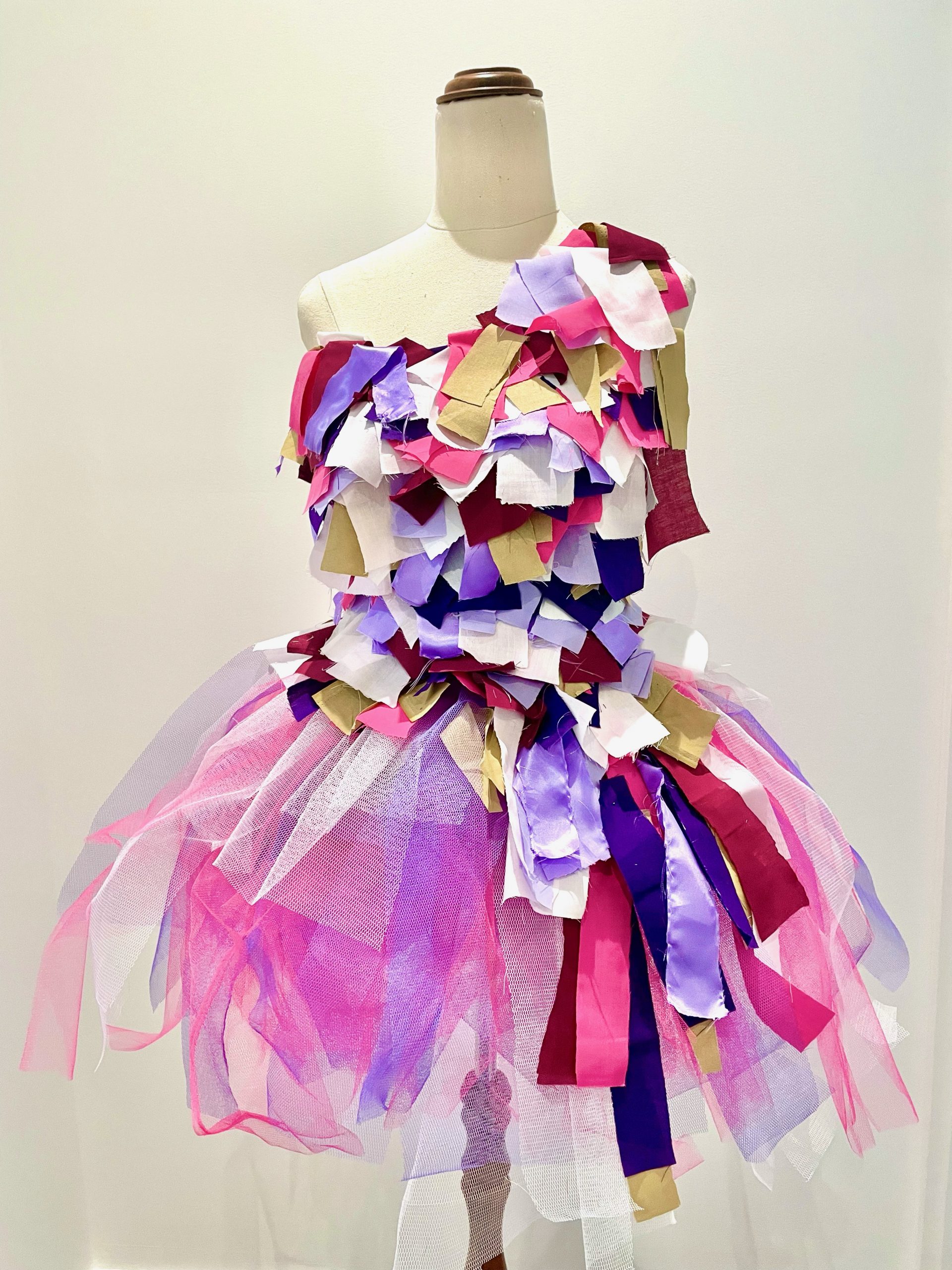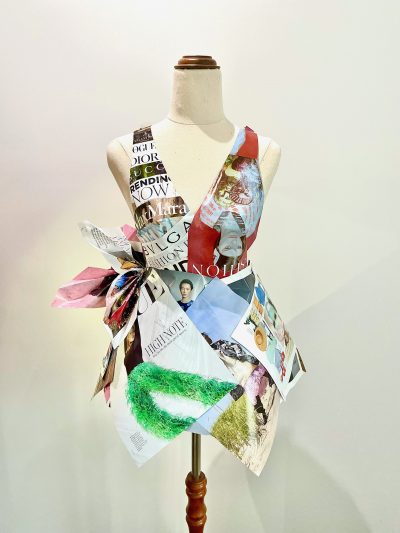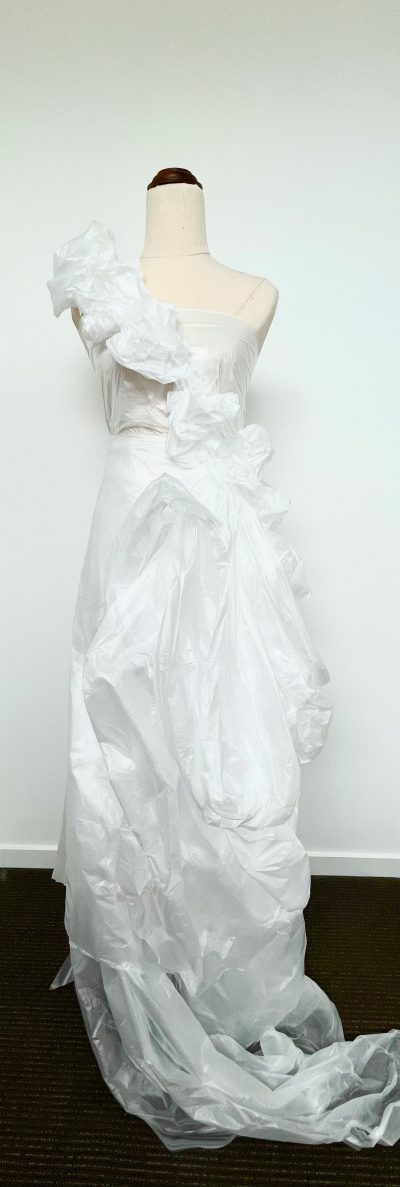
The Effects of Fast Fashion
These wearable art pieces represent just a small amount of the effects that fast fashion has on our environment. There are three pieces, ‘Pictures on Paper’, ‘Married to Plastic’ and ‘Piles of Fabric’, below is a rationale to each piece. Married to plastic and piles of fabric represent the waste and harm that the fast fashion industry has on our environment, while pictures on paper represent how the trends are constantly changing.
Pictures on Paper:

The term ‘fast fashion’ has become quite prominent in today’s conversations surrounding fashion and sustainability. Fast fashion is referred to cheaply priced and produced garments that replicate the latest catwalk styles and are both put on shelves and replaced within quick
succession to follow the latest and current trends. The biggest players in fast fashion are Zara, H&M, and UNIQLO1.
According to the UN Environment Programme, the fast fashion industry Is responsible for 10% of the world’s global carbon emissions which is more than all international flights and maritime shipping combined; as well as being the second-biggest consumer of water2.
Every day we are shown brightly lit displays, mannequins, and eye-catching magazines photos of brand-new clothing. We are constantly being consumed by the images showing new fashion trends on social media, consuming the words of celebrities and influences telling us what we should be wearing. We are told by fashion magazines, what is in and what isn’t, what celebrities are wearing, and the everyday individual simply cannot afford to replace their wardrobe every month with the clothes from the magazines, so they turn to the replicates created by fast fashion companies to keep up with the trends. In Europe, fashion companies in 2000 offered two collections a year, jumping to five in 20112. While fast fashion companies are offering even more, with Zara putting out 24 collections per year, and H&M offering between 12 and 162. This piece was designed to symbolise how fast we go through trends and how we find out about trends. Two major fashion magazines were used to create the effect given: Marie Claire and Vogue.
Married to Plastic:

The words ‘plastic pollution’ evokes images of discarded plastic bottles and bags, dropped cigarette butts, and fishing nets on the beach or floating underwater. While everyone can see this plastic, it is only part of the world’s plastic problem. The plastic we do not see is the microscopic plastic fibres that can be found in the water, the air, and accumulating on beaches3.
Research estimates that only 6% of the total mass of plastic entering the oceans is easily visible, most plastic breaks down into small micro-plastics and sink to the seafloor4. These invisible micro-plastics originate mostly from clothing made from synthetic fabrics such as nylon, polyester and rayon3. In 2016, 20% of the total plastic production for that year was produced for textile fibres, 35% of all micro-plastics are from these synthetic materials4.
Every time we wash a synthetic garment, roughly 1,900 individual micro-plastics are released into the water, making their way into the ocean2. Additionally, almost every time you purchase clothing, you will not only receive a plastic bag with your purchase but also plastic tags and if you order only plastic wrapping around each individual garment, showing just how much plastic comes from one garment.
This piece was made from plastic sheeting and created into a wedding dress, to symbolise the marriage like relationship we have plastic, we see plastic every day, we rely on plastic and even though we don’t want to have it in our lives anymore, outside factors are continually putting pressure on us not to change.
Piles of Fabric:

Each year 85% of all textiles go to dumps which enough to fill the Sydney Harbour annually, which equivalent to 50 billion plastic bottles2. According to the UN framework convention on climate change, emissions from textile manufacturing alone are projected to skyrocket by 60% by 20304.
It takes about 10,000 litres to produce only one kilogram of cotton, not only does fashion dry up water sources, but is one the biggest causes of water pollution2. The water leftover from the dyeing process is more times than not dumped into streams and rivers, polluting them, and turning them mostly bright colours such as pink or purple. To put this into perspectives, the dyeing process uses enough water
to fill an Olympic sized swimming pool over 2 million times each year2. A lot of the fast fashion factories are in countries with next to no environmental regulations, meaning all this untreated water enter their water sources pollutes them and, in many cases, becomes extremely toxic and cannot become safe again4. Furthermore, taking clean water from already poor and undeveloped countries.
Whether it is simply growing out of clothes or that clothes are no longer in style, a large amount of the population tends to throw away their clothes instead of donating. While this is a problem, the number of cut outs from clothing being made in factories, there is a large number of materials being wasted just in the process of making clothes. The piles of fabric being formed at dumps, later being incinerated, which leads to toxic gases being released to communities in surrounding areas, is detrimental to our environment.
This piece was designed to symbolise the wastage of fabric in the fashion industry. The colours were chosen to represent the colours that the waterways become because of the toxic dye which runs off into the rivers and streams.
Reference:
- Maiti, R. (2020). Fast Fashion: Its Detrimental Effect on the Environment. org. https://earth.org/fast-fashions-detrimental-effect-on-the-environment/
- McFall-Johnsen, M. (2019). The fashion industry emits more carbon than international flights and maritime shipping combined. Here are the biggest ways it impacts the planet. Business insider. https://www.businessinsider.com.au/fast-fashion-environmental-impact-pollution-emissions-waste-water-2019-10?r=US&IR=T
- Clingham-David, J. (2021). How the fast Fashion Industry Destroys the Environment. One Green Planet. https://www.onegreenplanet.org/environment/how-the-fast-fashion-industry-destroys-the-environment/
- Le, N. (2020). The Impact of Fast Fashion on the Environment. https://psci.princeton.edu/tips/2020/7/20/the-impact-of-fast-fashion-on-the-environment
